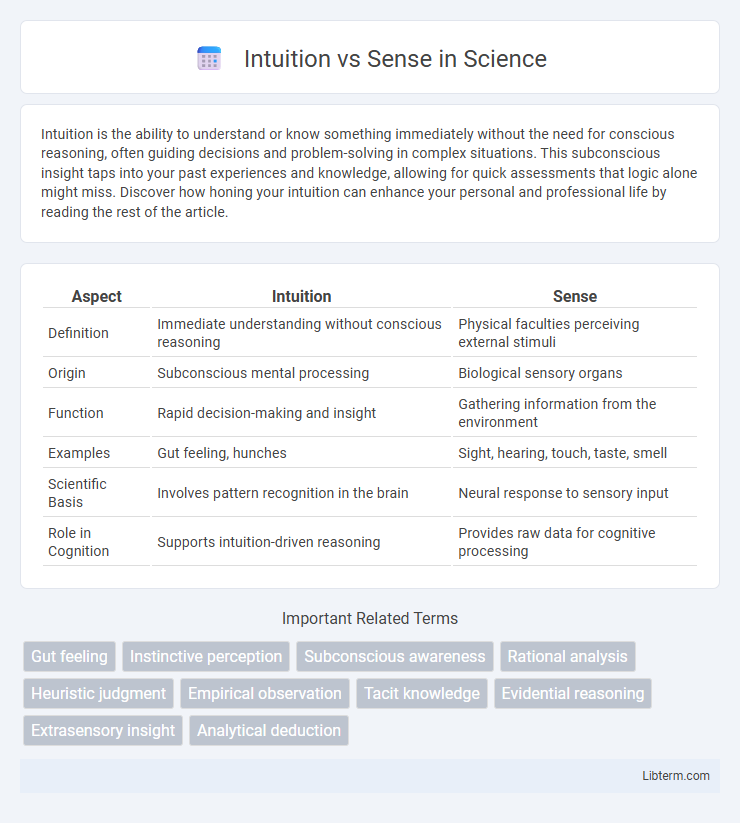Intuition is the ability to understand or know something immediately without the need for conscious reasoning, often guiding decisions and problem-solving in complex situations. This subconscious insight taps into your past experiences and knowledge, allowing for quick assessments that logic alone might miss. Discover how honing your intuition can enhance your personal and professional life by reading the rest of the article.
Table of Comparison
| Aspect | Intuition | Sense |
|---|---|---|
| Definition | Immediate understanding without conscious reasoning | Physical faculties perceiving external stimuli |
| Origin | Subconscious mental processing | Biological sensory organs |
| Function | Rapid decision-making and insight | Gathering information from the environment |
| Examples | Gut feeling, hunches | Sight, hearing, touch, taste, smell |
| Scientific Basis | Involves pattern recognition in the brain | Neural response to sensory input |
| Role in Cognition | Supports intuition-driven reasoning | Provides raw data for cognitive processing |
Understanding Intuition: A Brief Overview
Intuition is an immediate form of knowledge derived from subconscious processing, often bypassing analytical reasoning. It enables quick decision-making by leveraging patterns and experiences stored in the brain without deliberate thought. Unlike general sensory perception, intuition synthesizes complex information to generate insights that might not be immediately evident through sensory input alone.
Defining Sense: What Does It Really Mean?
Sense refers to the physiological capacity to perceive external stimuli through organs such as the eyes, ears, skin, nose, and tongue. It involves the detection and transmission of sensory information to the brain, allowing an individual to interpret the environment accurately. Unlike intuition, which is a cognitive process based on subconscious integration of experiences, sense is grounded in tangible, sensory input essential for immediate awareness and response.
Historical Perspectives on Intuition and Sense
Historical perspectives on intuition trace back to ancient philosophers like Plato, who viewed intuition as innate knowledge accessible beyond sensory experience, contrasting with Aristotle's emphasis on empirical observation through the senses. During the Enlightenment, thinkers such as Descartes distinguished intuition as a form of direct, rational insight, separate from sensory data, which was often considered unreliable. Over time, the debate evolved with psychologists like William James highlighting intuitive knowledge as a subconscious process, whereas sensory perception remained grounded in external stimuli and measurable phenomena.
The Science Behind Intuitive Thinking
Intuitive thinking arises from the brain's ability to rapidly process vast amounts of sensory data and past experiences, enabling quick judgments without conscious reasoning. Neuroscientific research highlights the role of the unconscious mind and brain regions such as the anterior cingulate cortex and insula in forming gut feelings and instinctive responses. This automatic, heuristic-based decision-making often improves efficiency and adaptability, especially under time constraints or complex scenarios.
Sensory Perception: How Our Senses Shape Reality
Sensory perception plays a crucial role in shaping reality by transmitting information from the external environment through sight, sound, touch, taste, and smell to the brain for interpretation. Intuition often arises from the subconscious processing of these sensory inputs, enabling rapid judgments without deliberate reasoning. Understanding the interplay between sensory data and intuitive insights reveals how humans construct a coherent experience of the world based on both conscious and unconscious information processing.
Intuition vs Sense: Key Differences
Intuition refers to the immediate understanding or insight without conscious reasoning, often driven by subconscious pattern recognition, whereas sense involves the five physical faculties--sight, hearing, touch, taste, and smell--that detect external stimuli. Intuition operates internally and abstractly, enabling quick decision-making based on experience and feelings, while sense provides concrete, sensory data from the environment. The key difference lies in intuition's reliance on internal cognition versus sense's dependence on external sensory input.
How Intuition and Senses Work Together
Intuition and senses collaborate by integrating subconscious insights with sensory inputs to enhance decision-making processes. While senses gather immediate data through sight, sound, touch, taste, and smell, intuition processes this information holistically, drawing on past experiences and emotional cues. This synergy enables individuals to interpret complex environments rapidly and respond effectively to diverse situations.
The Role of Emotions in Intuition and Sense
Emotions play a crucial role in shaping intuition by providing subconscious signals that guide immediate judgments without deliberate reasoning. Sense relies more on conscious emotional awareness, allowing individuals to process feelings and sensory information consciously for decision-making. Understanding the interplay between emotions and intuitive or sensory perceptions enhances accurate and timely responses in complex situations.
Practical Applications of Intuition and Sense
Intuition enables rapid decision-making by leveraging subconscious pattern recognition, crucial in fields like emergency medicine and creative problem-solving where quick judgments are vital. Sense, grounded in sensory perception and empirical data, supports accurate assessments in environments requiring precise measurement, such as engineering and scientific research. Practical applications balance intuition's ability to foresee outcomes with sense's reliance on observable evidence, optimizing decision quality and adaptability across diverse disciplines.
Cultivating Both: Enhancing Intuition and Sensory Awareness
Cultivating both intuition and sensory awareness strengthens decision-making and problem-solving abilities by integrating subconscious insights with concrete sensory data. Practices such as mindfulness meditation and focused observation enhance sensory perception while fostering intuitive clarity. Regularly engaging in reflective exercises and paying attention to bodily sensations deepen the connection between intuitive understanding and sensory input.
Intuition Infographic

 libterm.com
libterm.com